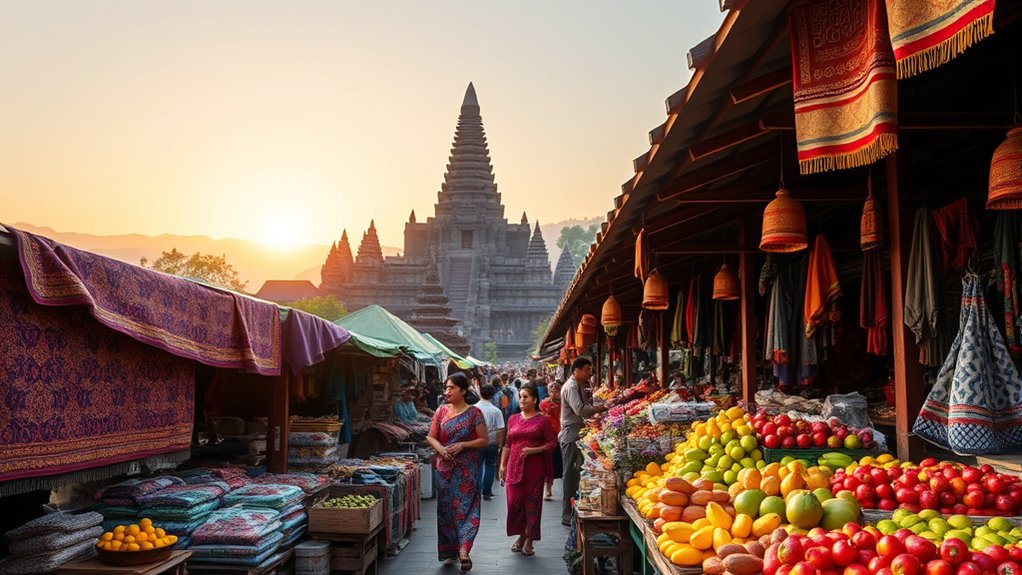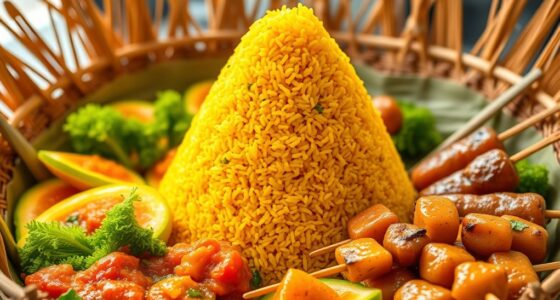Indonesia’s history spans from ancient kingdoms like Srivijaya and Majapahit, which shaped early culture and trade, to complex colonial encounters with the Dutch, Portuguese, and Japanese. Its diverse society blends Islamic, Hindu-Buddhist, and indigenous traditions, reflecting a rich cultural tapestry. The nation’s fight for independence, political changes, and modern developments have transformed its society today. To uncover more about Indonesia’s fascinating legacy and vibrant customs, explore the many stories that make up this dynamic country.
Key Takeaways
- Indonesia’s history spans over a million years, shaped by Hindu-Buddhist empires, Islamic sultanates, and European colonial powers.
- Colonial rule transformed social structures, leading to independence in 1945 and the development of a unified national identity.
- Post-independence political shifts included Sukarno’s guided democracy, Suharto’s New Order, and reforms after 1998.
- Indonesia boasts diverse cultural traditions, including traditional dances, ceremonies, crafts, and cuisine that reflect its rich heritage.
- Continuous preservation of cultural practices and heritage sites sustains Indonesia’s vibrant and evolving cultural landscape.
Ancient Foundations and Early Kingdoms
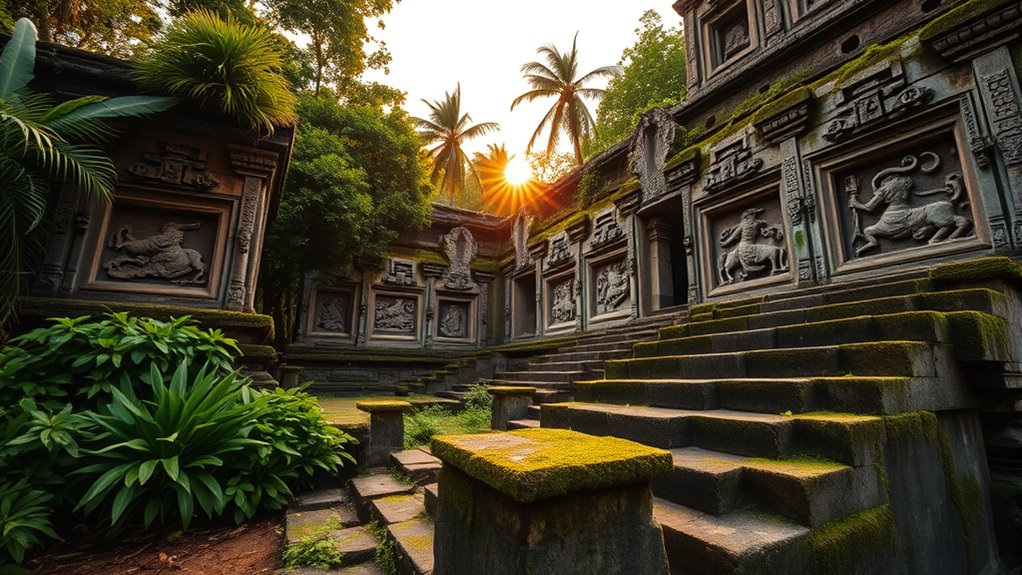
Have you ever wondered how Indonesia’s rich history began? Archaeological evidence shows humans inhabited this land over a million years ago. As time passed, religions and cultures gradually arrived, with Hindu-Buddhist influences reaching Java and Sumatra by the 4th or 5th century CE. These early beliefs shaped powerful kingdoms like Srivijaya, a major Buddhist maritime empire controlling trade from the 7th to 13th centuries. Later, the Majapahit Empire emerged in Java during the 13th century, blending Hindu and Buddhist traditions across the archipelago. Simultaneously, Islamic sultanates like Aceh and Demak arose from the 13th century onward, marking the beginning of a diverse religious landscape. These early kingdoms laid the foundation for Indonesia’s complex history and cultural richness. The development of early kingdoms was greatly influenced by the spread of religions and the integration of diverse cultural practices.
Colonial Encounters and European Influences

You see that European traders arrived in Indonesia driven by the desire to control the lucrative spice trade and expand their influence. They established trading posts and later imposed colonial administrations to secure their interests, often reshaping local societies in the process. As a result, indigenous cultures faced significant changes, blending with European influences and facing new economic and political challenges.
European Trade Interests
What drove European powers to venture into Indonesia’s archipelago was their relentless pursuit of valuable spices and commodities that could boost their economies. They sought control over the lucrative spice trade, especially cloves, nutmeg, and mace, which were highly prized in Europe. Portuguese explorers arrived first in Maluku in 1512, aiming to dominate the spice routes and establish trading posts. The Dutch followed, establishing the Dutch East India Company (VOC) in 1602 to secure these resources. They built fortified trading hubs, manipulated local politics, and enforced monopolies to maximize profits. European interests also extended to controlling key maritime routes and access points, using military force when necessary. Their engagement transformed Indonesia into a essential node in global trade networks, laying the groundwork for future colonization efforts.
Colonial Administrative Strategies
European powers implemented a range of administrative strategies to solidify their control over Indonesia’s diverse territories. They established colonial bureaucracies, often replacing local leaders with European officials or co-opting indigenous elites to enforce policies. They divided regions into administrative units, streamlining governance and taxation. They also created legal codes based on European models, suppressing traditional laws. To maintain order, they deployed military force when necessary, such as during the Aceh War. These strategies aimed to maximize resource extraction and control trade routes, often disregarding local social structures, which led to resistance and long-lasting impacts on Indonesian society. Additionally, the colonial administrations often employed resource extraction policies that prioritized economic gain over local well-being.
Impact on Indigenous Societies
Colonial encounters profoundly reshaped indigenous societies in Indonesia by disrupting traditional social structures and cultural practices. When Europeans arrived, they imposed new political boundaries, often disregarding existing ethnic and social groups. The Dutch, in particular, introduced systems like the Cultivation System, which forced indigenous farmers into cash crop production, altering local economies and social hierarchies. Christian missionaries spread new religions, challenging indigenous beliefs and practices, especially in Bali and eastern regions. Colonial authorities also suppressed local customs, replacing them with European norms and administrative methods. Indigenous leaders were often marginalized or co-opted, weakening traditional authority. Over time, these influences blended with local cultures, creating hybrid identities but also causing loss of indigenous traditions, social cohesion, and autonomy. Additionally, the colonial period introduced new forms of cultural exchange that further complicated the social fabric of indigenous communities.
The Path to Independence and National Identity
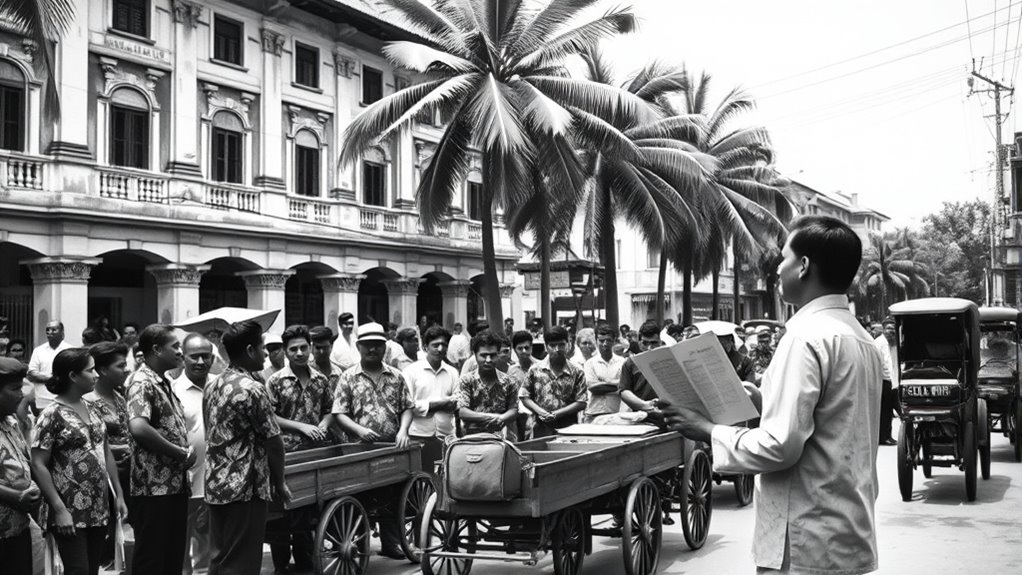
The journey toward Indonesia’s independence was shaped by a growing sense of national consciousness that emerged amid centuries of foreign domination and internal diversity. You witnessed early movements like Budi Utomo (1908) and Sarekat Islam (1911), which sparked unity. The Japanese occupation (1942–1945) weakened Dutch control and gave nationalist leaders essential experience. On August 17, 1945, Sukarno and Hatta declared independence, inspiring a fierce struggle. This led to the Indonesian National Revolution (1945–1949), where diplomacy and armed resistance secured sovereignty. Your awareness of shared history, language, and culture fueled the desire for unity. Here’s a quick overview:
| Event | Impact |
|---|---|
| Budi Utomo | Sparked national awakening |
| Sarekat Islam | Mobilized mass support |
| Japanese Occupation | Accelerated independence plans |
| Proclamation | Formal declaration of independence |
| Revolution | Achieved sovereignty |
Additionally, the development of a national identity played a crucial role in uniting diverse ethnic groups and fostering a sense of pride and collective purpose throughout the struggle for independence.
Political Transformations in Post-Independence Indonesia

After achieving independence through a hard-fought revolution, Indonesia faced the challenge of establishing a stable political system. Sukarno initially led a democratic government but soon shifted to “Guided Democracy” in 1959, centralizing power and emphasizing nationalism. The late 1950s and early 1960s saw economic struggles, regional rebellions, and political instability. A failed coup attempt in 1965, blamed on the Communist Party, triggered mass anti-communist massacres and led to Suharto’s rise. He established the New Order, consolidating power, suppressing dissent, and prioritizing economic growth. The Asian Financial Crisis of 1997–98 sparked protests, forcing Suharto to resign in 1998. Indonesia then progressed to democracy, embracing regional autonomy, free elections, and a multiparty system, while facing ongoing issues like corruption and sectarian tensions. Additionally, the development of Unique and Wicked Planters and other innovative gardening tools reflects Indonesia’s growing interest in sustainable and creative urban agriculture practices.
Contemporary Society and Cultural Expressions
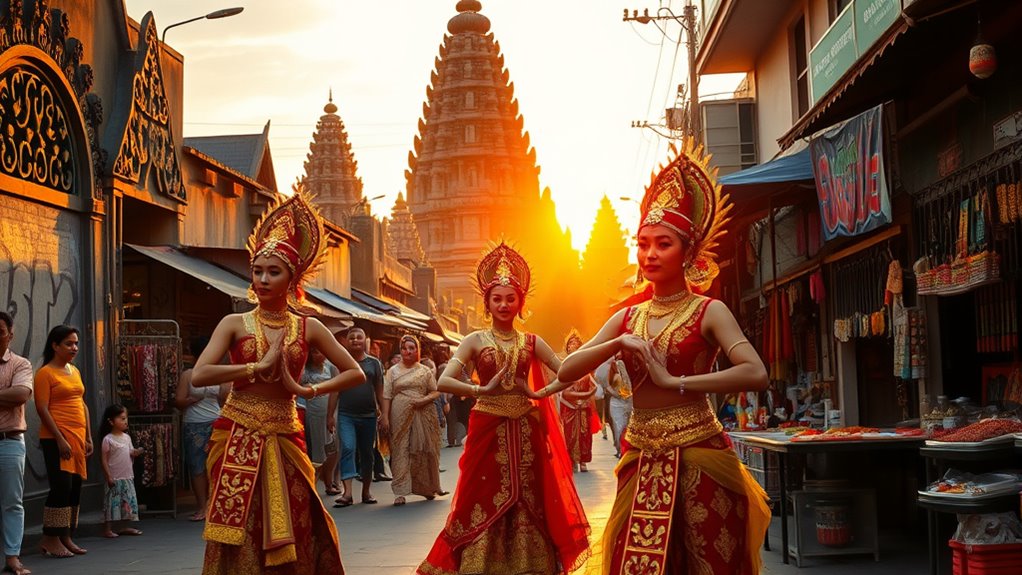
How does Indonesia’s vibrant society continue to evolve today? You see it in the lively mix of modern arts, media, and digital innovations. Traditional crafts like batik and wayang still thrive, blending with contemporary design and fashion. Cinema and literature explore social issues, reflecting diverse perspectives across the archipelago. Social media amplifies voices, connecting young Indonesians with global trends while celebrating local culture. Music genres like dangdut and pop fuse traditional instruments with modern sounds, creating fresh expressions. Urban centers like Jakarta and Bali become hubs for creative entrepreneurs, promoting cultural tourism and innovation. Despite challenges, Indonesia’s cultural diversity remains a key strength, shaping an evolving society that honors its heritage while embracing the future.
The Rich Tapestry of Indonesian Traditions
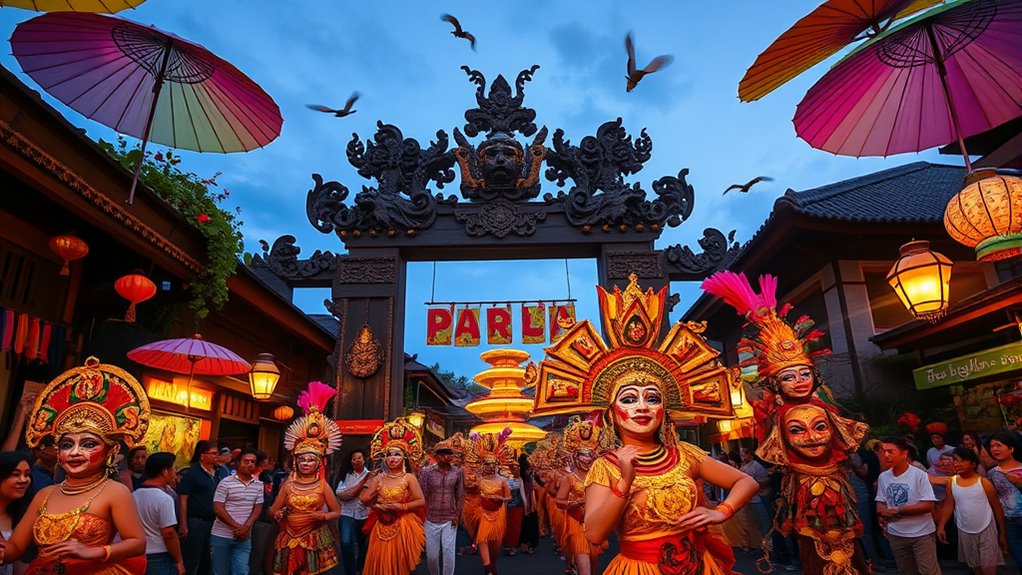
Indonesia’s rich traditions weave a vibrant tapestry that reflects its diverse cultural landscape. You can explore this through colorful ceremonies, intricate crafts, and unique performances. Batik textiles, with their detailed patterns, tell stories of local history and beliefs. Gamelan music and wayang kulit puppet shows highlight Indonesia’s artistic heritage, often linked to spiritual and cultural themes. You might participate in vibrant festivals like Nyepi in Bali or the Toraja funeral rites, which blend ancestral customs with religious practices. Traditional dances such as the Saman or Kecak express community unity and cultural identity. Food also plays a crucial role, with regional dishes like Padang’s spicy rendang showcasing local flavors. These traditions, passed down through generations, keep Indonesia’s cultural diversity alive and thriving today. Additionally, the preservation of traditional arts and crafts is vital to maintaining Indonesia’s unique cultural identity.
Frequently Asked Questions
How Have Indonesia’s Diverse Ethnic Groups Influenced Modern National Identity?
Your understanding of Indonesia’s diverse ethnic groups shows how they shape the nation’s identity. You see that over 1,300 ethnicities and 700 languages contribute to a rich cultural mosaic. The national language, Bahasa Indonesia, unites everyone, while regional traditions like music, dance, and cuisine reflect local influences. This diversity fosters a sense of unity in variety, making Indonesia’s identity uniquely vibrant, inclusive, and constantly evolving through shared cultural expressions.
What Role Does Indonesia’s Maritime History Play in Its Cultural Development?
You see that Indonesia’s maritime history deeply shapes its culture today. It’s a story of vibrant trade routes, seafaring skills, and diverse port cities. You’ll notice influences from Indian, Chinese, Arab, and European traders reflected in local arts, cuisine, and traditions. The sea connects communities, fosters cultural exchange, and sustains livelihoods, making maritime heritage a core part of Indonesia’s national identity and cultural richness.
How Has Islam Uniquely Integrated With Local Traditions in Indonesia?
You see how Islam in Indonesia uniquely integrates with local traditions through syncretism and adaptation. You notice that indigenous practices, such as ancestor worship and local rituals, blend seamlessly with Islamic principles, creating a diverse spiritual landscape. You can observe this in ceremonies like the Wali Songo’s efforts to spread Islam across Java, where Islamic teachings merge with existing cultural customs, making religion deeply rooted in local life and identity.
In What Ways Has Indonesian Cinema Evolved in Recent Decades?
You see Indonesian cinema evolve through greater diversity and global influences in recent decades. You notice filmmakers blending traditional stories with contemporary themes, experimenting with genres, and embracing digital technology. Local stories gain international recognition at film festivals, while independent productions flourish. You also observe increased political and social commentary reflecting Indonesia’s changing society, alongside a rise in popular commercial films that showcase cultural identity and modern aspirations.
How Do Regional Arts Reflect Indonesia’s Historical Trade Connections?
You see that regional arts in Indonesia vividly reflect its historical trade connections through intricate textiles like Batik, which was influenced by Indian and Chinese motifs. Traditional dance and music, such as Gamelan in Java and Bali, incorporate elements from ancient maritime exchanges. These arts showcase a blend of cultural influences from traders and explorers, highlighting Indonesia’s role as a vibrant hub of international trade and cultural exchange for centuries.
Conclusion
As you explore Indonesia’s rich history and vibrant culture, you’ll see a nation shaped by ancient kingdoms, colonial influences, and a resilient pursuit of independence. Did you know that Indonesia is home to over 300 ethnic groups and more than 700 languages? This diversity enriches its traditions and society, making Indonesia a truly fascinating tapestry of history, culture, and hope for the future. Embrace its complexity, and you’ll gain a deeper appreciation of its remarkable story.

